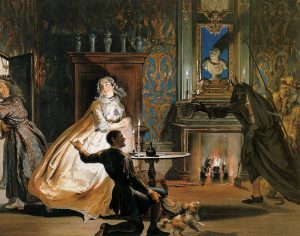What is gilt leather?
Gilt leather was one of the most luxurious types of wall decoration in the Western world. Until the late 18th centuries high-status public buildings - palaces, stately homes, upper-class mansions - were adorned with it. Beside wall hangings, gilt leather has also been used as an upholstery material for folding screens, chairs, kneelers, chests, portieres and canopies, as covers for various kind of costly furniture as tables and chairs, for altar frontals and ecclesiastical vestments, and even for (real) paintings.
Origins
Gilt leather making was a craft that originated in North Africa (Ghadames, Libya). It spread in the Late Middle Ages through Spain to the rest of Europe, concentrating in centers such as Cordoba, Venice, Rome, Malines, Amsterdam, Paris and London.
All that glitters is not gold!
The shiny surface on gilt leather is not real gold. The golden surface is created by silver leaves coated with an oil-resinous varnish intensely coloured with yellow substances such as aloe and saffron. These ‘gilded’ leather panels are subsequently decorated with fashionable ornamental patterns.
The designs and decorative motives are either directly transferred to the silver leaf (or the gold varnish) with inked wooden moulds, or they are directly impressed on moist leather, after the gilding, with wooden or metallic moulds, adequate to give the surface a more or less sharp relief.
The transferred designs are often painted with covering pigments, but mostly with transparent organic colours, lacquers and coloured varnishes in an oil medium. Gilt-leathers with a flat surface are further impressed with punches which border and enhance the scenes and motifs, often complete them, and make vibrant the unpainted gold or silver surfaces. The decoration obtained with plates and moulds is repeated skin after skin, or divided over a few skins, which once connected form a continuous design. The assembly of artefacts is completed by sewing or by gluing the decorated skins.
Two aspects characterize this craft from the beginning. Firstly the closeness to other fields of contemporary artistic production -such as textiles and goldsmith design work- from which its rich decorative repertory derives.
Secondly there is a close connection with painting. In various cases gilt leather is used as a support for real paintings. More important are the cooperative relationships between gilt-leather workers and painters. Their artistic input was vital both for the execution of more complex scenes and decorations, as for the renewal of traditional patterns.
Conservation challenges
Gilt leather is extremely sensitive: methods used for leather conservation may damage the painted layers; and accepted (or common) methods in use for painting conservation are destructive for the vulnerable gold varnish layer.
Many gilt leather objects are in a perilous condition, or have already been lost. Gilt leather conservation requires an interdisciplinary teamwork of specialised conservators, art historians and scientists with an up-to-date knowledge of the fast growing analytical techniques. Only a select group of specialised conservators is aware of the various conservation issues and the risks involved in certain restoration treatments.

Patterns
Ornaments and styles tended to follow contemporary stylistic trends, though there are many examples of continued use of classic and sometimes even outdated patterns. The more common motifs are vegetable and flower patterns, either stylized or naturalistic: woven fruits and flowers arranged in festoons, in bunches within vases, forming bundles and wreaths, often with small animals, insects, putti or other decorative elements. Depending on the period and geographical area, other motives are added too, derived from heraldry, architecture, “grotesque” genre, etc. For wall hangings also large painted scenes were applied, usually from the bible, classical scenes or landscapes, resembling tapestries or monumental paintings.
A delicate sandwich of materials
Gilt leather is a sophisticated and delicate material. It may be considered as a painting on leather. However the layering is inversed. In paintings the varnishes sits on top of the paints and glazes. In gilt leather the paints and glazes are applied on top of the varnish and silver layer. The specific layering of materials is as follows: leather, animal glue, silver leaf, oil-resin varnish, and oil paints, glazes and varnishes. This sandwich of materials makes conservation and restoration a real challenge.
Diverse names
In literature different names can be found for gilt leather, such as gilded leather and gold leather. The only correct term to use is gilt leather.
The preferred words in other languages:
- Danish: gyldenlæder
- Dutch: goudleer
- Flemish: goudleder
- French: cuir doré
- German: Goldleder / Ledertapete
- Italian: cuoi dorato
- Japanese: kinkarakawa
- Norwegian: gyldenlær
- Polish: kurdyban
- Portugese: guadamecis
- Spanish: guadamecil
- Swedish: gyllenläder